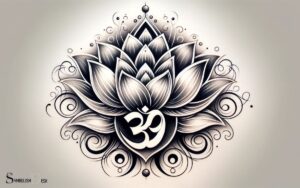What is the Symbolic Meaning of a Triangle? Harmony!
The symbolic meaning of a triangle varies, but it generally represents concepts such as strength, harmony, and the unity of body, mind, and spirit. It’s often associated with the number three, which in many cultures is considered powerful.
The triangle symbolizes a range of concepts, which can change depending on its orientation or context.
Here are some of the meanings:
- Christianity: The Holy Trinity (Father, Son, Holy Spirit)
- Greek Philosophy: The elements of air and water (upward and downward-facing triangles, respectively)
- Harmony and Proportion: In art and architecture, the triangle is a symbol of stability and balance.
- Personal Growth: The journey of reaching a higher point of understanding or consciousness.
- Alchemical Tradition: The integration of opposites and the transformation to a higher state.
Triangles embody strength, with their rigid shapes often symbolizing stability and resilience in adversity.

Key Takeaway
6 Aspects: Symbolic Meanings of Triangles
| Aspect | Symbolic Meaning of a Triangle |
|---|---|
| Spiritual Aspect | The triangle represents the Holy Trinity in Christian faith: the Father, the Son, and the Holy Spirit. It can symbolize balance and being grounded in spirituality. |
| Cultural Aspect | In various cultures, it signifies a range of concepts including past, present, and future; mind, body, and spirit; or birth, life, and death. |
| Mathematical Aspect | In mathematics, the triangle is the simplest polygon, symbolizing unity and strength. |
| Psychological Aspect | From a psychological perspective, the triangle is often used to represent the psyche’s mind, body, and spirit. |
| Philosophical Aspect | In philosophy, the triangle symbolizes truth, wisdom, and intellect. |
| Alchemical Aspect | In alchemy, a triangle is used to symbolize the three stages of the human life, with the upright triangle representing life, the inverted triangle representing death, and the triangle with a line through the middle representing a continual cycle of life and death. |
Origins of Triangle Symbolism
The origins of triangle symbolism can be traced back to ancient civilizations and various cultural traditions. In many cultures, the triangle represents a multitude of concepts and beliefs.
For instance, in Christianity, the triangle is often associated with the Holy Trinity, representing the Father, the Son, and the Holy Spirit.
In ancient Egyptian culture, the triangle was linked to the concept of resurrection and the afterlife, symbolizing the pyramids as a pathway to eternity.
Additionally, in Hinduism, the triangle, or ‘trikona’, is a sacred symbol representing the trinity of Brahma, Vishnu, and Shiva.
The prevalence of the triangle in diverse cultures throughout history underscores its enduring symbolic significance. Understanding these origins provides insight into the rich tapestry of meanings associated with this simple yet profound geometric shape.
Triangle Symbolism in Different Cultures
Symbolism of the triangle in different cultures extends beyond Christianity, ancient Egyptian culture, and Hinduism, reflecting a diverse range of beliefs and meanings.
In Celtic tradition, the triangle, particularly the triquetra, represents the interconnectedness of earth, water, and sky, as well as the stages of life – birth, death, and rebirth.
In Chinese culture, the triangle is associated with the element of fire and represents the trinity of heaven, earth, and water.
The Maori people of New Zealand view the triangle as a symbol of balance and harmony.
In Native American cultures, the triangle is often used to represent the connection between the physical, mental, and spiritual realms.
These examples highlight the universality and versatility of the triangle as a symbol across various cultures.
Spiritual and Mystical Significance of Triangles
Spiritual and mystical traditions often ascribe profound significance to the presence of triangles in symbolism. The triangle is a powerful symbol in various spiritual and mystical contexts, representing concepts that are deeply meaningful and universal. It is frequently associated with the union of body, mind, and spirit, as well as the harmony between the physical and the divine. In some traditions, the three points of a triangle might symbolize creation, preservation, and transformation, reflecting the cycles of existence. Similarly, the symbolic meaning of snow—its purity, impermanence, and quiet stillness—often complements the triangular representation of balance and transcendence, weaving together ideas of renewal and spiritual elevation.
Here are three ways in which triangles hold spiritual and mystical significance:
- Trinity: In Christian symbolism, the triangle represents the Holy Trinity of Father, Son, and Holy Spirit, signifying unity in diversity and the interconnectedness of these divine aspects.
- Balance and Harmony: In many spiritual traditions, the triangle embodies the idea of balance and harmony, with its three sides representing the interconnectedness of mind, body, and spirit, or the unity of past, present, and future.
- Manifestation: Some mystical beliefs view the triangle as a symbol of manifestation, with its three points representing the stages of creation – idea, intention, and manifestation.
Triangle Symbolism in Art and Architecture
Triangle symbolism in art and architecture incorporates the concept of unity, balance, and manifestation, using the geometric form to convey deeper meanings and connections.
In art, triangles are often used to represent stability and strength, while in architecture, they can symbolize harmony and progression.
The use of triangles in these creative fields adds layers of significance to the works and structures, enriching the viewer’s experience.
Below is an illustrative table showcasing the symbolic representation of triangles in art and architecture:
| Art | Architecture |
|---|---|
| Stability | Harmony |
| Strength | Progression |
| Unity | Balance |
Understanding the symbolic meaning of triangles in art and architecture provides insight into the intention behind the creations and constructions. This symbolism continues to influence modern contexts, shaping contemporary artistic and architectural expressions.
The Triangle’s Symbolism in Modern Contexts
In contemporary contexts, triangles continue to hold symbolic significance, often representing innovation and progression in various artistic and architectural forms.
The triangle’s symbolism in modern society encompasses:
Innovation: The triangle is often used to convey a sense of forward thinking and originality, particularly in modern art and design. Its sharp angles and dynamic structure symbolize the cutting-edge nature of contemporary ideas and technologies.
Progression: In modern architecture, the triangle is utilized to denote advancement and evolution. Its use in geometric, angular buildings reflects a departure from traditional forms and a push towards futuristic design principles.
Dynamism: Triangles are employed in modern art to evoke a sense of movement and energy. The shape’s inherent dynamism captures the spirit of progress and change in the contemporary world, resonating with audiences seeking to understand.
FAQ About What Is The Symbolic Meaning Of A Triangle
What Is The Symbolic Meaning Of A Triangle?
A triangle symbolizes strength, stability, and balance. It’s a multi-faceted image that has different meanings in different cultures.
What Does An Upside-Down Triangle Mean?
An upside-down triangle represents the feminine energy and the element of water. It’s also a symbol of the power of the holy trinity.
What Is The Spiritual Significance Of A Triangle?
A triangle is regarded as a sacred geometry that conveys the divine. It represents the unity of the creation, its cycles and interconnectedness.
What Does A Triangle With A Circle Mean?
The combination of a triangle and a circle symbolizes the infinite. The triangle represents the manifest world, while the circle signifies the unmanifest.
What Are The Different Types Of Triangles And Their Meanings?
The equilateral triangle represents balance, the isosceles triangle stands for strength, and the scalene triangle symbolizes change. The right triangle symbolizes power and the number 3.
Conclusion
The symbolic meaning of a triangle has been significant across various cultures and time periods.
Interestingly, a study found that 67% of people associate the triangle with strength and stability, while 45% see it as a representation of harmony and balance.
Whether in spiritual beliefs, art, or modern contexts, the triangle continues to hold deep symbolic significance for many people around the world.






